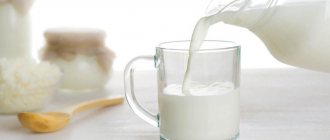There is an opinion that milk weakens the harmful and enhances the beneficial effects of caffeine on the body, so drinking coffee with milk is not only tasty, but also healthy. Let's figure out if this is so.
Coffee is rich in vitamins and antioxidants. But it also contains acids that irritate the gastric mucosa. Coffee increases the secretion of gastric juice. If this happens in the morning, before breakfast, when the stomach is still empty, hydrochloric acid can seriously injure the mucous membrane. Therefore, drinking coffee on an empty stomach is undesirable even for healthy people. In case of high acidity, stomach ulcers, or a removed gallbladder, doctors strongly recommend limiting the consumption of the drink.
Milk is alkaline. The fat it contains softens the effect of acids. So coffee with milk is not as harmful for people with gastrointestinal diseases as regular espresso. In addition, milk weakens the effect of caffeine on blood vessels, so coffee with milk does not cause such sudden surges in blood pressure as black coffee. It’s not for nothing that Italians in the morning drink not the universal alarm clock espresso, but a softer cappuccino.
It would seem that from the above it follows that coffee with milk is useful for hypertensive patients. But the problem is that milk contains casein. Casein glue is one of the strongest. To verify this, just try to wash a pan with milk that has dried to the walls without using detergents.
Coffee with milk pollutes the body
The same thing happens on the inner surface of the walls of blood vessels. The adult human body simply does not have enzymes capable of breaking down casein. Protein often causes constipation, which causes fecal stones to form in the intestines and toxins to enter the bloodstream. Due to slagging in the body, the skin becomes covered with rashes, including purulent ones. If you drink milk from time to time, the body has difficulty, but copes with the “complex” product. But if coffee with milk becomes a regular habit, the likelihood of vascular disease increases.
Many lovers of coffee milkshakes are sincerely convinced that milk compensates for the lack of calcium, which is washed out of the bones under the influence of coffee. But this is a dangerous misconception: the body is not a children’s construction kit; the processes of saturating it with calcium are very complex. For example, calcium is poorly absorbed if there is a lack of silicon. For those who eat few vegetables, which is why they do not receive enough silicon, calcium does not strengthen bone tissue, but only promotes the deposition of salts, and no amount of milk can help here. The older a person is, the faster his body loses calcium and the more difficult it is to restore calcium balance.
The conclusion follows: milk slightly softens the immediate effect of coffee on the gastric mucosa and the cardiovascular system. But it does not slow down the process of leaching calcium from bone tissue. You can pay for the abuse of coffee and milkshakes by blocking blood vessels, digestive disorders and constant constipation.
Contraindications to drinking coffee with milk are almost the same as for black coffee:
- gastrointestinal diseases;
- tendency to constipation;
- hypertension and other diseases of the cardiovascular system;
- removed gallbladder;
- pancreatitis;
- sensitive skin, prone to rashes;
- osteoporosis;
- individual intolerance to coffee or milk.
Of course, for all of the above categories, coffee with milk is not fatal. If you really want to, you can drink a coffee and milkshake several times a month. But if your health worsens, it is better to give up coffee in all forms.
A completely healthy person under the age of 30 should not drink coffee with milk more than 2-3 times a week. After 30 years - no more than 1 - 2 times a week.
Сafé au lait
Europeans began to discover the taste of the coffee drink at the end of the 16th century, and only a century later in Europe the tradition of mixing it with milk appeared.
It was started by the French : they became famous for their creative approach to creating culinary recipes.
By mixing brewed coffee with hot milk, they opened the world to a drink that is now known to all coffee gourmets under the name “café au lait” .
What underlay its appearance - the desire to create a healing drink or a banal attempt to get rid of the inherent bitterness of coffee with milk - is unknown.
But the union turned out to be successful .
Benefits of energizing caffeine
The coffee fruit, like a living laboratory of nature, combines many organic elements. It contains more than thirty organic acids, essential oils, protein, mineral salts, alkaloids (this includes caffeine).
Caffeine gives a tonic effect. A small amount of it excites the nervous system and cerebral cortex.
The overall metabolism improves, breathing increases, blood circulation accelerates, and the vital activity of the whole organism increases.
Why is the drink of vigor bitter?
Caffeine has a bitter taste , which leads many to mistakenly believe it is responsible for bitterness. But another useful alkaloid is responsible for the taste and aroma - trigonelline.
At high temperatures, it forms nicotinic acid - a B vitamin , which prevents the occurrence of a number of serious diseases, for example, pellagra (vitaminosis). In Latin American countries, where coffee is consumed in incredible quantities, there is almost no vitamin deficiency among the malnourished poor.
Fragrant oils, beneficial acids
Essential oils, which also have an antiseptic effect, also provide additional aromas.
Thanks to organic acids - malic, acetic, citric - the drink speeds up digestion, improving the functioning of the stomach .
The fruits of the coffee tree are also rich in tannins – antioxidants that prevent cancer and cardiovascular diseases.
They are also responsible for the bitterness of the decoction. Milk, when interacting with tannins, binds them, reducing bitterness.
We recommend reading about the dangers and benefits of green tea - another tonic drink that is popular among supporters of a healthy diet!
You will learn the beneficial properties of chamomile tea and the recipe for the miracle drink from our special material.
What are the benefits of dry red wine? Answers to questions about him are here: .
Mutual enrichment
The components enrich each other with the beneficial qualities inherent in each.
At a time when the “black” ingredient removes calcium and vitamins from the body, the “white” ingredient, rich in these substances, comes to the rescue, compensating for the loss.
Coffee in a healthy combination is responsible for vigor, because warm milk is a relaxing and soothing drink.
Black coffee with milk is a smoothly stimulating drink.
After drinking a cup, vigor comes gradually and lasts for about three hours.
And important: excitement does not give way over time to depression, which happens after drinking stronger drinks.
Is coffee with cream harmful?
I must admit that most nutritionists are not enthusiastic about including such a drink in the daily diet. Nikola Djordjevic, MD, encourages us to think seriously about our overall healthy eating habits. He believes that any product can be hazardous to health when we take it in unlimited quantities. Therefore, the doctor says: “The best thing we can do for our body is to observe moderation in everything.”
If you limit yourself to one tablespoon of creamer per day added to your coffee, and your overall diet is not loaded with trans fats and sugar, then such moderate consumption is unlikely to disrupt your plans to maintain a healthy diet.
When you significantly increase this rate, your body receives significantly more fat and sugar than you think. Nutritionist Kristen Carley urges: “Ask yourself: How much cream are you putting in a cup? How many cups of coffee do you drink every morning? Depending on the type of creamer and how much you use, you could easily reach your daily sugar limit."
The American Heart Association recommends limiting your sugar intake to half your daily calories: 6 teaspoons for women and 9 teaspoons for men.
Against diseases
Often, in order to maintain the tone of people suffering from diseases for which a concentrated drink is strictly prohibited, doctors include coffee (preferably natural) diluted with milk in their diet.
A weak coffee-milk mixture is drunk for chronic gastritis, dumping syndrome, liver and gall bladder diseases, and in the most limited quantities for atherosclerosis.
For heart failure, doctors sometimes consider it necessary to recommend a small amount of natural coffee with milk, because caffeine forces the heart muscle to contract more vigorously.
Coffee with skim milk is recommended for diabetes and obesity.
For galactosemia (a disease associated with the lack of a digestive enzyme), milk is not recommended - this can lead to gastrointestinal upset.
For chronic and short-term stomach upsets, it is also better not to drink a coffee-milk mix.
Allergies to dairy products, colitis, gastritis with low acidity of gastric juice and dysentery are diseases in which dairy products are generally prohibited.
The vigor drink has long been famous as an effective method of combating headaches caused by migraines. During attacks of the disease, the blood vessels of the brain are dilated, and caffeine, by narrowing them, relieves pain. A coffee-milk mix is not as good as black coffee, but if the latter is prohibited, it still alleviates the condition.
Should you drink milk: a nutritionist on the benefits and dangers of your favorite product
Since childhood, most people perceive milk as an integral element of proper nutrition, but recently more and more studies have appeared indicating the dangers of this product. On World Milk Day, a RIAMO correspondent together with nutritionist Natalya Pugacheva tried to figure out whether it’s worth drinking milk, what arguments its supporters and opponents give, and how to choose a quality product.
Proteins, fats and essential minerals
According to Natalya Pugacheva, a nutritionist at the Health Management Clinic of the Institute of Personalized Medicine at Sechenov University, milk is one of the whole food products; it cannot be considered clearly a friend or an enemy.
“Milk and dairy products are rich in complete, easily digestible protein - cottage cheese and cheeses are not inferior in the amount of protein to meat and fish. Milk fat is very heterogeneous in composition and, in addition to saturated fats and dietary cholesterol, the dangers of which are often exaggerated, contains essential fatty acids, mono- and polyunsaturated. The milk fat drops also contain lecithin, fat-soluble vitamins A, E, and D,” says the expert.
Milk protein, like fat, according to the expert, is heterogeneous - it consists of casein and whey proteins (lactoglobulins and lactoalbumins). Thanks to this, it is complete and is 95% absorbed by the body.
For comparison, the expert cites the example of legume protein, which, despite its high nutritional value, the body can only absorb 30-40%.
The nutritionist considers the mineral composition to be another indisputable advantage of milk and products made from it. “First of all, we are talking about calcium. There is relatively little of it in milk or kefir itself - about 100 milligrams per 100 grams (with an average daily intake of 1000 milligrams). But hard cheese already contains 1000 milligrams of calcium per 100 grams. Taking into account the fact that with dairy products a person receives calcium in an optimal combination with vitamin D and phosphorus, it is difficult to replace them with something else,” Natalya Pugacheva is convinced.
For sufficient calcium intake, she advises consuming two to three servings of dairy products per day, for example, a glass of milk or kefir, 100 grams of cottage cheese and 30 grams of cheese.
Increased insulin, bad cholesterol and estrogens
Over time, information about the dangers of milk is becoming more and more: the popular product is accused of leading to brittle bones and increasing mortality rates. In milk, scientists found an insulin-like growth factor, which is considered one of the prerequisites for excess weight and cancer, as well as cholesterol, which causes atherosclerosis. In addition, the product that cows produce during pregnancy contains estrogens.
“Most of the accusations against milk appeared, oddly enough, in the wake of scientific discoveries, but if you look at the research results without hysterics and loud revelations, everything is not entirely true,” Natalya Pugacheva is sure.
According to the nutritionist, there is indeed a growth factor in milk, but its share is less than one percent of a similar factor produced by the body. A high insulin index is also present, but the increase in insulin levels after consuming dairy products was not associated with increased glucose levels, an increased risk of diabetes, or obesity in the studies. It's the same with cholesterol.
“Excess dietary cholesterol is harmful, more than 300-400 milligrams per day. This amount can be found in 3-4 liters of milk, 500 grams of cottage cheese or 250 grams of cheese. But such portions will seem unreasonable for most people,” explains Natalya Pugacheva.
The results of a study on the effect of milk on increasing mortality rates, which was conducted at Harvard University, are also ambiguous. Scientists compared groups that drank different amounts of milk. A higher mortality rate was observed when consuming 7 or more servings.
“The researchers themselves make a reservation that people in this group generally ate much more - not just milk. It’s difficult to pinpoint milk as the reason for the deterioration of their health,” comments the nutritionist.
Who shouldn't have milk?
First of all, these are those who are allergic to a certain protein, most often casein. “Allergies appear already in infancy, when feeding with formula or cow's milk begins.
The symptom can be either a disruption of the intestines or a skin rash,” says Natalya Pugacheva. People with lactose intolerance, that is, milk sugar, also need to be careful with dairy products.
In infancy, it is absorbed by the enzyme lactase. As you grow older and switch to an adult diet, the activity of the enzyme decreases, and milk sugar is less absorbed, and its excess in the intestines disrupts the functioning of the microflora. “Lactase deficiency in adults is determined genetically. A lot of data has been accumulated on population differences in the activity of the gene responsible for this enzyme.
Thus, among the indigenous inhabitants of northern Europe, people with lactose intolerance are much less common than among people from Asia or Africa,” explains the nutritionist. According to her, absolute intolerance is rare - more often its manifestations depend on the quality of the milk consumed. People over 25 years old can skip whole milk altogether, getting the necessary vitamins and minerals from fermented milk products, such as cottage cheese or cottage cheese. During their production, lactic acid bacteria “eat up” almost all the lactose.
In addition, people with lactose intolerance can replace regular milk with lactose-free or plant-based milk. When making lactose-free milk, the lactase enzyme is added to regular milk, and a product with already broken down sugar ends up on store shelves.
Plant-based versions resemble milk made from seeds, nuts, or grains in appearance. “Plant milk is a wonderful product in every way. It is a source of vegetable protein and healthy fats, vitamins and microelements. In addition, this “milk” also contains dietary fiber. Vitamins D and B12 are added to some types, which are not found in the original cereals or seeds. This makes plant milk especially attractive for vegetarians,” says Natalya Pugacheva.
Which milk to choose
According to information posted on the Roskachestvo website, the safest way to buy milk is to choose a product from a large manufacturer in a supermarket. Milk purchased at the market from a farmer or from a neighbor's grandmother is not always safe, because the owners may not notice the disease in the cow in the early stages.
You should also be careful with milk dispensers that sell raw milk. If boiling instructions are not followed, the consumer may receive unwanted microflora in addition to their morning cup of milk.
Roskoshestvo experts do not recommend consuming raw milk - it is better to pay attention to pasteurized, ultra-pasteurized or sterilized milk.
These heat treatment methods differ in the temperature and duration of heating the milk. For example, pasteurized milk is heated to 70 degrees, which preserves all its beneficial properties. The shelf life of such a product is 5-10 days. Ultra-pasteurized and sterilized milk have a significantly longer shelf life - up to six months at a temperature not exceeding +25 degrees. To achieve this, the milk is heated strongly - in the first case to 137 degrees for a few seconds, in the second to one hundred for 20 minutes. When buying milk, you need to pay attention to the packaging. It must be opaque and airtight - bacteria can enter the product along with air, and in sunlight, milk fat is susceptible to photo-oxidation. If the packaging is damaged, the expiration date has expired, or the milk was stored in incorrect conditions, for example, pasteurized outside the refrigerator, you should not buy the product - it may be spoiled. Link to publication: korzinka.riamo.ru
Light version
Making instant coffee with milk is easier and faster than natural coffee, and many people simply like its taste better.
But it doesn't have as much caffeine as black.
Usually there is three times less of this alkaloid in a soluble drink.
By adding milk, you don't have to worry about overstimulation.
There is almost no cafestol in the instant drink.
This molecule gives the natural drink antioxidant properties. However, it is also responsible for increasing cholesterol levels.
So for people whose cholesterol levels have already exceeded the norm or have hereditary heart problems, it is better to be satisfied with a coffee-milk mix.
Roasting and main coffee varieties
Initially, coffee beans are green or yellow in color; as they ripen on the tree, they turn red. The collected coffee is roasted in a roaster using hot air. There is a separate profession of coffee roasters, who know all the tricks of this art: the duration and temperature of roasting will affect the taste of the finished drink and its properties. For example, light roast coffee is more acidic, has a higher pH level, has a sharper taste and more acidity. Dark roast coffee has a richer flavor, more bitterness, and contains less caffeine. The usual brown color of coffee comes from caramel, which is released from the beans during heat treatment.
Arabica and Robusta are the two main varieties of coffee that are most often found on store shelves. Choosing one of them is a matter of taste. The Arabica variety grows only in the mountains, it is more demanding to care for, and therefore often costs more. Arabica beans contain about 1.5% caffeine and 98.5% other substances, including vitamins, amino acids, antioxidants, tannins and many others. Compared to Robusta, Arabica has less caffeine, it has a richer taste and a slight sourness. Robusta contains more caffeine, and therefore a more bitter taste and heavy aroma.
Time to stay awake
A person’s desire to sleep is due to the inhibition of cells in the cerebral cortex. Caffeine interferes with this process. Therefore, morning coffee helps you wake up .
An additional portion of it, drunk in the evening, can lead to insomnia . Although there is confirmed evidence that drinking coffee and milk before bed helps older people who complain of insomnia to fall asleep.
In very weak concentrations, it is also sometimes recommended for children with increased activity.
The digestive system is also susceptible to the drink. After a glass of drink after dinner for dessert, the secretion of gastric juice will increase, the digestion process will be activated, and food will be better absorbed.
How to use it correctly and how much
When to drink coffee is a completely individual matter. But if you consume it, listening to what the experts say, it will provide good concentration during the day and quality soy at night.
When should you drink coffee? Morning is not an ideal time. According to scientists, the first cup should have been drunk between 8:30 and 9:30 am (assuming that the person gets up between 6:00-8:00 am). The next cup can be drunk in the 2nd half of the day (from 13:30 to 17:00). Drink your last coffee between 17:30 and 18:30. It is not advisable to consume a caffeinated drink later - it can become an obstacle to good sleep.
Preparation
To create an aromatic coffee-milk mix, raw coffee fruits must be fried at low temperature on a well-preheated frying pan or baking sheet. Adding a little butter won't hurt. The grains need to be stirred from time to time until they acquire a dark brown color. The main thing is to remove it on time.
For those who like light coffee, one teaspoon of ground beans per 200 g of water is enough, for those who like it stronger - 2-3 spoons.
The cezve is heated in advance , rinsed with boiling water, the tea leaves are placed in it, poured with hot water and, having brought to a boil, immediately removed. Let it brew for 5 minutes and pour into cups.
Now is the time to add warmed but not boiled milk. Its fat content does not matter for a healthy person. For those who are contraindicated in consuming animal fats, there is skim milk.
See how you can quickly and deliciously make coffee with milk at home in this video:
Calorie content of the drink
No matter how you drink your coffee (without milk, with milk, with or without sugar , with whipped cream and syrup), when you add certain ingredients, the drink becomes a bigger, more insidious calorie bomb than you think. In particular, dairy products and sugar increase the fat and calorie content. For example, a latte (coffee with a large dose of milk) is comparable in energy value to a hamburger!
Turkish coffee:
- Coffee beans + water.
- Kcal: practically none.
- Fat: none.
Espresso:
- Coffee beans + water + sometimes milk.
- Kcal: small portion – 11, large – 20 (more when adding sugar, milk).
- Fat: none (provided no other ingredients are added).
Cappuccino:
- Espresso + hot frothed milk.
- Kcal: small portion – 120, large – 200.
- Fat: small portion – 6 g, large portion – 10 g.
Latte:
- Espresso + hot milk.
- Kcal: small portion – 200, large – 350.
- Fat: small portion – 10 g, large portion – 18 g.
Let's limit ourselves to two servings
The eternal culprit in debates about the dangers and benefits of aromatic drinks - caffeine - can have both a tonic and a depressant effect . To feel invigorated, 1-2 teaspoons of coffee per 120-200 g of water is enough, which corresponds to approximately 0.1-0.2 g of caffeine. Doctors regard 0.3 g of this alkaloid as a one-time dose as risky.
Having drunk more than a couple of servings in a row, soon after the mood rises, a person will experience irritability, nervousness, trembling in the hands, and an increased heart rate.
If this becomes a habit, these symptoms can become chronic.
Find out about the dangers and benefits of tea with ginger, its healing properties and therapeutic effect on the pages of our website!
Did you know that chicory is a caffeine substitute? Read this article about the benefits of instant drinks.
What are the benefits of black tea with milk? You will learn about the properties of this drink in this article:.
Pregnancy and children
For women who are accustomed to 2-3 servings daily, during pregnancy it is better to limit themselves to a minimum amount of a weak coffee-milk mix.
But nursing mothers do not need such drinks: the nicotinic acid they contain can adversely affect the growth of the child. For the same reason, it should not be given to young children.
The joys of coffee are also not recommended for teenagers, because at this age the nervous system is very vulnerable.
Men and women
The effect on the stronger and weaker sex is somewhat different.
As a result of the tests, it turned out that mental activity after two servings of sugar in women is more active than in men, especially under stress.
In men, sexual activity increases . And with regular moderate consumption of coffee drinks, reproductive abilities also increase.
With prolonged abuse, the result will be the opposite. This also threatens enuresis and insomnia.
Caffeine is a preventative against male diseases: prostate cancer and liver cancer.
To avoid the risk of Parkinson's disease, men will need more coffee than women, and in the case of diabetes, the opposite is true.
How to choose milk for coffee?
When choosing milk for cappuccino and other coffee drinks, it is worth considering several factors that will affect the final taste and quality. Of course, first of all, it is the taste of the milk itself, which the drink will acquire. The protein content will affect the stability of the foam, and the fat content will determine the density of the drink.
The optimal solution would be milk with 3.2% fat content: the foam will be stable and dense.
Is it possible to make a milky coffee drink with foam from lactose-free milk? Of course, you can - after all, the ability of milk to froth does not depend on the lactose content. The milk sugar content can affect the taste of the drink: lactose is thought to make it sweeter. However, this is not always applicable: for example, Valio Eila - milk created by membrane filtration does not differ in taste from regular milk, while Valio Eila is whipped into a thick, dense foam that does not settle for a long time.
For those who prefer to drink coffee with cream, experts advise choosing a fat content of no more than 10%, since an even fatter product dissolves much less well and will float in the cup in lumps.
To decorate drinks and for whipping, it is better to take cream with 30–38% fat content. Valio's range also includes whipping cream 36%: you can whip it with sugar and sprinkle cinnamon or chocolate on top - you get a real coffee dessert.
In general, there are now alternatives on the market for making coffee for every taste - all you have to do is use your imagination!
Slenderness
You may notice that coffee drinkers are usually agile and slim. Caffeine promotes weight loss. There are several reasons for this.
Thanks to its invigorating effect, it encourages a person to move and act. At the same time, it suppresses appetite, and after drinking a portion without sugar and milk, which contains only 7 calories, for two or three hours the strong desire to eat something will be absent.
Even a couple of tablespoons of milk (low-fat) and a dessert spoon of sugar will not add many calories. The wasted energy will exceed the received.
Caffeine is a good diuretic . This is one of the components of weight loss drugs.
But at the same time, the body leaves the body with the most important microelements: calcium and magnesium. To avoid serious health problems, they will have to be constantly replenished.
How does it affect weight loss?
When following a diet, the type of milk used plays an important role, as it increases the nutritional value of the drink.
First of all, beware of sweetened, whipped cream. When these ingredients are added, a low-energy drink can suddenly become an energy bomb. From an energy point of view, you can add a little low-fat or semi-skimmed milk (maximum 20 ml). Those with a sweet taste can use artificial sweetener.
Important! When losing weight, avoid whole milk, cream, whipped cream, and white sugar.
Coffee cosmetology
Natural coffee is often used in home cosmetology.
To create cosmetics, the grounds formed during the process (without sugar) are usually used. Masks, creams, lotions, for which it serves as a basis, cleanse and tone the skin, and even help fight cellulite.
It’s easy to prepare a nourishing toning mask that deeply cleanses the skin : you need to take 1 dessert spoon of coffee grounds, sugar, full-fat milk and ground cinnamon, a pinch of salt, a little olive, almond or peach oil.
Mix the ingredients until a homogeneous mass is obtained and apply it to the face for 15 minutes, avoiding the areas around the lips and eyes. Then rinse with warm water.
After this procedure, the skin should rest for about an hour.
In this video, watch how to prepare a face scrub at home:











